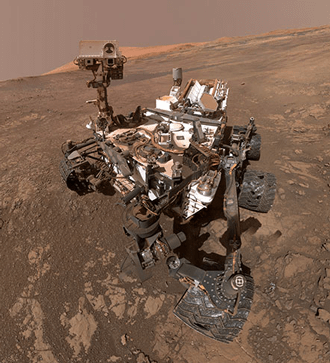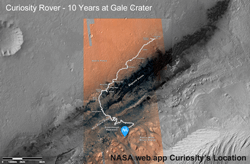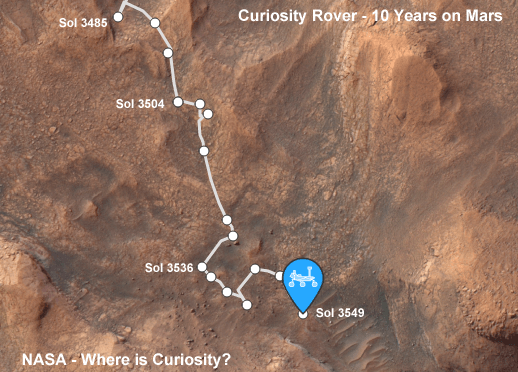
August 2022 - Vol. 26, No. 8
This Month's Night Sky - NOTE: The next paragraph describes the sky as it appears at 10 pm EST (11 pm EDT) near mid- month. The sky also looks this way at 11 pm EST (midnight EDT) during the beginning of the month and at 9 pm EST (10 pm EDT) by month's end.
Bright blue-white Vega (Lyra) shines high overhead as it "leads" the Summer Triangle across the night sky. The "Triangle" is the summer’s most prominent asterism and is made up of three stars: Vega, the brightest, Deneb (Cygnus) and Altair (Aquila). Scorpius and the bright star Antares occupy the southern sky. Look for another famous asterism, “the teapot” (Sagittarius). The stars of constellations Scorpius and Sagittarius, embedded in the "Milky Way" (part of one of the spiral "arms" of our galaxy), are at their best this month.
MERCURY presents the best evening apparition for observers in the southern hemisphere. VENUS in the morning sky can be observed but moves ever closer to the Sun in preparation for superior conjunction in October. MARS crosses into Taurus on the 9th, finally reaching its opposition destination. It will shine at 0.0 mag by month's end. JUPITER moving in retrograde motion in the constellation of Cetus. SATURN reaches opposition on August 14, at .3mag. URANUS is in conjunction with Mars on the 1st. NEPTUNE is in the constellation of Pisces, rising in the evening hours, heading toward opposition on September 16.

Curiosity Rover celebrates ten Earth years on Mars. Landing at Gale crater on August 6, 2012, the Mars rover has traveled 18 miles and climbed 2,000 feet!
Review how to determine Angular Measurement.
Calendar of Events
NOTE: For those observers not in the ET zone, convert the calendar times to your zone's time by subtracting one hour for CT, two for MT and three for PT. Don't forget to adjust for Daylight Savings Time when necessary by subtracting one hour from your planisphere's time. Dawn and dusk times must also be corrected. See your local newspaper, TV news, or cable TV's Weather Channel for sunrise and sunset times or check with the U.S. Naval observatory. Unfortunately some of these events may occur during daylight hours in your area.
| DATE | EVENT |
| 01 | Mars 1.4 deg. S. of Uranus. |
| 04 | Mercury 0.7 deg N. of Regulus. |
| 10 | Moon at perigee. |
| 12 | Saturn 4 deg. N. of Moon. |
| 13 | Perseid Meteor peak, occurs 1 day after full Moon, so it won't be an impressive shower this year. The Perseid meteors are the result of dust ejected as Comet 109/Swift-Tuttle has crossed Earth's orbit repeatedly over many thousands of years. |
| 14 | Saturn at opposition. Neptune 3 deg. N. of Moon. |
| 15 | Jupiter 1.9 deg. N. of Moon. |
| 18 | Uranus 0.6 deg. S. of Moon, occultation from Micronesia, Hawaii, Alaska, northernmost USA, Canada, Greenland, Iceland. |
| 19 | Mars 3 deg. S. of Moon. |
| 22 |
Moon at apogee. Vesta at opposition. |
| 23 | Mercury at aphelion. |
| 24 | Uranus stationary. |
| 25 |
Venus 4 deg. S. of Moon Ceres 0.7 deg. N. of moon, occultation from S. and E. Polynesia and the S. tip of S. America. |
| 27 |
Mercury at greatest elongation E. (27deg.) Mars at quadrature (a 90-deg. angle is created by Earth, Sun, and Mars). |
Lunar Almanac for August 2022
| Phases of the Moon | Phase and Date(s) | Best viewed before local midnight |
 |
New 27 |
Deep Space Objects |
 |
1st. Qtr 05 |
Planets & Moon |
 |
Full 11 |
Moon |
 |
Last Qtr 19 |
Deep Space & Planets |
Topic of the month: Curiosity Celebrates 10 Years on Mars

Curiosity landed in Gale Crater, a large impact crater on Mars located at 5.4°S 137.8°E on August 6, 2012. The rover was built by NASA and the Jet Propulsion Laboratory (JPL). About the size of a car, Curiosity was launched from Cape Canaveral, FL, on November 26, 2011. It was gently set down by a special landing spacecraft known as a "skycrane" on Mars at Aeolis Palus, inside the crater, below Aeolis Mons, familiarly known as Mount Sharp. NASA was able to land Curiosity in the area it had designated after a 350-million mile (560-million km) journey. After a successful landing, the site where Curiosity landed was renamed Bradbury Landing.
Gale Crater is 96 miles or 154 km in diameter. It is thought to be about 3.5 billion years old. Aeolis Mons is a mountain in the center of Gale, it rises 3.4 miles or 5.5 km above the floor of the crater. It is believed that the crater was once the site of a lake on Mars. Curiosity found evidence of water soon after landing. Indeed, smooth, rounded pebbles such as those found on Earth gave evidence of a sustained flow of water around the rocks.
Curiosity is scaling up the side of Mount Sharp testing the surface for geological information as it travels. The rover travels at the rate of ~660 feet (200 m) per day over flat ground. As of August 1, 2022, Curiosity has traveled 17.64 miles or 28.4 km from the Bradbury landing site. It has gained over 2,000 ft. in elevation!
Curiosity is looking for organic compounds that should be present if life can evolve on Mars. It has found such compounds in the samples it collected. It also found that ancient Mars could have supported life, it was habitable. Curiosity's Tunable Laser Spectrometer (TLS) measures methane, carbon dioxide and water vapor in the Martian atmosphere. This instrument indicates that the level of methane near the surface is variable, suggesting some process occurs on Mars that has not yet been fully explained. Methane can be produced by living organisms or by chemical reactions between rock and water, so understanding the process is important.
It hasn't been all smooth sailing for Curiosity either. The rover's wheels showed lots of wear so the path the rover takes on Mars is carefully selected to avoid further damage. This brought about a change to the design of Perseverance rover's wheel. Problems that developed with Curiosity's drill forced engineers at NASA to find a solution. They developed a successful plan and now Curiosity has a new method for drilling into rocks.
- - Find out more about Curiosity at Astra's Stargate
Where is Curiosity?

NASA has provided an interesting app to figure out where Curiosity is on its trek from the basin of Gale Crater. The site will appear as it does in the thumbnail, with the surface of Mars in gray and the area of rover's path in color. It may be a little hard to see on the image because the entire track of the rover is highlighted. Below is a close up of the area where Curiosity is currently exploring. It is blown up to great detail and information of some of the "sols" or martian days was added the image.
Hovering over a dot or "waypoint" will give you the date when Curiosity was at that location. Information on the exact coordinates on Mars are given. These images were captured from the screen using the tools that are available on the site. On Sol 3549, Curiosity was located at 137.4 latitude, -4.76 longitude on Mars. Site tools also allow users to change the appearance of the map.
Using the Where is Curiosity map will show you the fascinating details of the terrain that the rover is crossing. The waypoints show how rover drivers can point Curiosity at nearby formations so that Mars exploration is carried out by humans using the remote robot.

Go to NASA's Where is Curiosity?
The map was created with image data from the Context and the HiRISE cameras on NASA’s Mars Reconnaissance Orbiter. A higher resolution map with elevation data is used by the actual rover drivers to steer Curiosity toward the most interesting surface features as continues exploring Mars. NASA has another web app to allow visitors to experience Mars exploration called Explore with Curiosity. Try it for yourself!
--See You Under the Stars!
Astra for Astra's Almanac
The Curiosity path image was created by Dawn Jenkins, using NASA's Where is Curiosity webapp and a graphic editing program to format the image for this web page. Editing was done for educational purposes only. Where is Curiosity is soley a JPL/NASA production! Thank you to NASA!
This installment of "What's Up?" is ©2022 by Dawn Jenkins for Astra's Stargate. View Ron Leeseburg's Farewell Issue for information on where to find information such as is presented in this almanac.